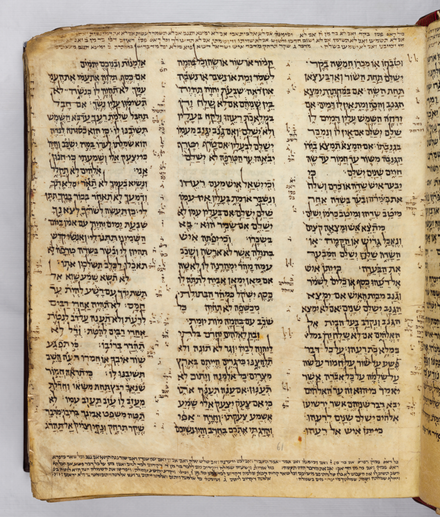
WASHINGTON — Famed New York City auction house Sotheby’s — known for selling pricey art, jewelry, furniture, and wine — is about to delve into the spiritual world when it auctions the oldest, most-complete Hebrew Bible in May.
The manuscript, more than 1,000 years old, is called the Codex Sassoon, named for its onetime owner, David Solomon Sassoon, a collector in England. It is expected to sell for $30-$50 million during its May 16 auction.
The ancient text has long held a “revered and fabled place in the pantheon of surviving historic documents and is undeniably one of the most important and singular texts in human history,” said Richard Austin, global head of books and manuscripts for Sotheby’s, in background information provided by the auction house.
And Sharon Mintz, senior Judaica specialist with Sotheby’s books and manuscripts, said the manuscript “marks a critical turning point in how we perceive the history of the divine word across thousands of years and is a transformative witness to how the Hebrew Bible has influenced the pillars of civilization — art, culture, law, politics — for centuries.”
Put simply, the manuscript is a big deal. Researchers say it provides the basis of biblical translations used today by Jews, Christians, and the Islamic faith that teaches that the Torah and Psalms contained within the Hebrew Bible are divinely revealed.
“The Codex Sassoon is a wonderful thing; it’s a treasure that has been hidden,” said Roy Heller, professor of the Hebrew Bible at the Perkins School of Theology at Southern Methodist University in Dallas. He also said the work is “one of those things that tie people together.”
Since 1989, this codex — which includes most of the original text of the 24 books of the Hebrew Bible, save for 12 pages from the Book of Genesis — has been owned by a Swiss collector. The travels of this ancient text, prior to 1989, could almost write a book.
According to historians, a scribe wrote the Codex Sassoon in the late 9th or early 10th century, and the manuscript made its way to a synagogue in present-day Syria. After the synagogue was destroyed around the 13th or 14th century, the text disappeared for the next 600 years. It resurfaced in 1929, was purchased by Sassoon and remained in his family for about 50 years before being sold a few more times.
Just prior to the upcoming auction, the bound volume of 400 pages (below) of ancient parchment was on display in London and Tel Aviv. In late March, it was shown at the Museum of the Jewish People in Tel Aviv — for timed visits of 10 minutes each. It will also be shown in Los Angeles and at the Southern Methodist University’s Bridwell Library, April 18-20.
Anthony Elia, di-rector of the university’s library and associate dean for special collections and academic publishing, said SMU was the only university to exhibit the text and the school was “honored to share this treasure with the public.”
A key aspect of this manuscript, beyond its age and near-complete collection, is that it also contains something akin to a pronunciation guide known as the Masorah, compiled by Hebrew Bible scholars called the Masoretes.
This guide alone is why one scholar told The Tablet he couldn’t put a price on the ancient manuscript and why he is concerned that its sale could result in the codex being once again shut away by a private owner.
James Hanges, professor and chair of the comparative religion department at Miami University in Ohio, said the manuscript has much value and significance, particularly since it was made at a time when Jewish scholars were trying to make Hebrew Bible texts more accessible to Jews who were living around the world and did not always speak Hebrew. The notes in the manuscript essentially make the text accessible because they show the reader how it should be read. Hanges also said this guide provided a way for the Jewish community to solidify itself and preserve its unity amid persecution.
Hanges said he will be watching to see who buys the manuscript, noting it will likely be out of reach for a vast majority of museums around the world and that a private owner could loan it to a museum, but also might not.
“It depends on their sense of social obligation,” he said.
